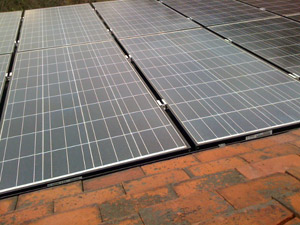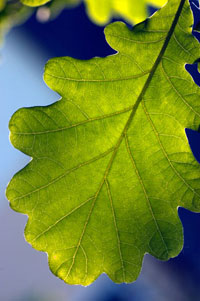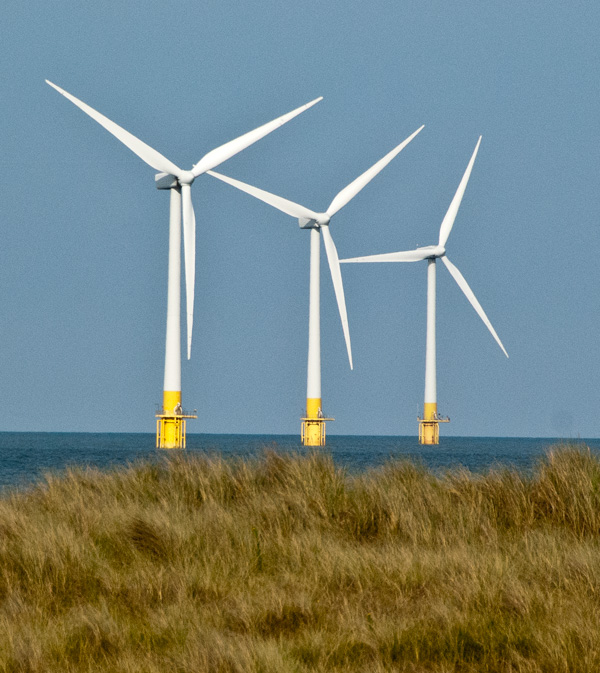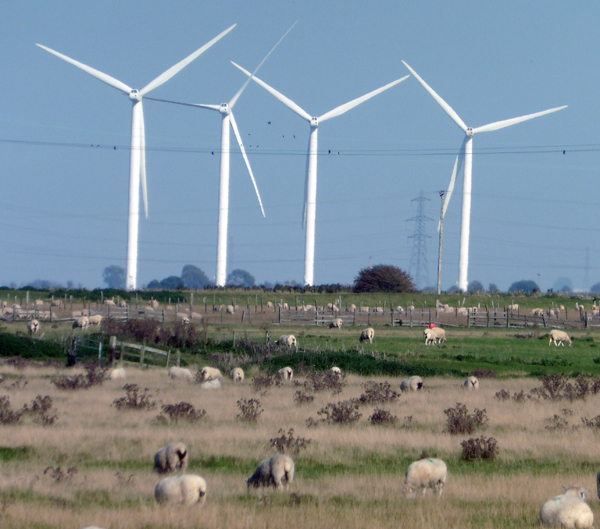Renewable energy from solar energy and woodfuel

People respond emotionally to wind turbines but seem happy to see their neighbours installing solar panels. This acceptance of solar made me keen to install solar panels at home, which we have just done.
The process has taught me a lot, not least because it showed me how ignorant I was about the economics of domestic energy use - whilst we all know the cost of petrol few of us are aware of the price of a unit of domestic electricity - maybe physical volumes are easier to understand than something that goes down wires and is measured in confusing units.
Our 19 solar panels produce about 3.5 kilowatts, so if our annual production is about 1,000 hours we should produce 3,500 kwH of energy which turns out to be a high proportion of our domestic useage. Many British homes consume about this amount each year, so if I am able keep our consumption down we might even become net exporters.
Producing renewable energy has a surprising and almost miraculous effect on the producer which other observers have confirmed: one might think that people who generate electricity would become profligate in their energy use, but in fact the opposite effect is much more common. When you know how hard it is to generate power you tend to want to reduce your own consumption. In my case, I have replaced all our light bulbs with low energy bulbs.  The effect on consumption is amazing - many of the 50 watt bulbs have been replaced with 5 watt bulbs which give out a similar amount of light - yes that's right they use one tenth as much electricity! It's amazing how many people worry about turning lights off while those lights that they are using consume ten times as much as they need to. But whilst all this economising is very worthwhile it does not capture the main area of energy consumption in most British homes which is heating - to put this in perspective my own annual energy bills look like this: electricity - 6,000, gas 24,000. (all in kilowatt hours). That's right, we use 4 times as much energy for heating as we do for lighting.
The effect on consumption is amazing - many of the 50 watt bulbs have been replaced with 5 watt bulbs which give out a similar amount of light - yes that's right they use one tenth as much electricity! It's amazing how many people worry about turning lights off while those lights that they are using consume ten times as much as they need to. But whilst all this economising is very worthwhile it does not capture the main area of energy consumption in most British homes which is heating - to put this in perspective my own annual energy bills look like this: electricity - 6,000, gas 24,000. (all in kilowatt hours). That's right, we use 4 times as much energy for heating as we do for lighting.
 This high cost of heating explains why the really big energy savings are to be made in insulation and heating systems and it also explains why the Forestry Commission and others feel that woodfuel use is so important. For many people one reason for buying a wood of their own is that they can grow their own woodfuel (and of course the process of collecting and processing also creates "warmth" through exercise). But there are interesting comparisons to be made between the economics of solar and woodfuel which you gather from your own woodland. First of all the solar panels will use the sun more efficiently than trees do. Panels can collect about 20% of the energy that lands on them compared to a theoretical physical maximum of about 27%.
This high cost of heating explains why the really big energy savings are to be made in insulation and heating systems and it also explains why the Forestry Commission and others feel that woodfuel use is so important. For many people one reason for buying a wood of their own is that they can grow their own woodfuel (and of course the process of collecting and processing also creates "warmth" through exercise). But there are interesting comparisons to be made between the economics of solar and woodfuel which you gather from your own woodland. First of all the solar panels will use the sun more efficiently than trees do. Panels can collect about 20% of the energy that lands on them compared to a theoretical physical maximum of about 27%.
 By contrast only 2% of solar energy which lands on plants is used and much of that is not converted into timber. So the trees convert vastly less of the sun's energy but they are, of course, covering a far larger surface area of land. So how much useable timber is produced from a woodland? Foresters measure this in terms of "yield class" - where a woodland of yield class 10, for example, produces 10 tonnes per hectare each year. This means that a 7.5 acre woodland (3 hectares) might grow 30 tonnes of timber each year. Excluding the summer months that's about a tonne of firewood each week, which is more than would be needed for heating a single dwelling. That firewood can be looked at in terms of its calorific value where in principle a tonne of firewood can produce about 4,000 kwH, so to heat a house like mine you would need about 6 tonnes of firewood each year, which is the timber grown on about 1.5 to 2 acres of woodland.
By contrast only 2% of solar energy which lands on plants is used and much of that is not converted into timber. So the trees convert vastly less of the sun's energy but they are, of course, covering a far larger surface area of land. So how much useable timber is produced from a woodland? Foresters measure this in terms of "yield class" - where a woodland of yield class 10, for example, produces 10 tonnes per hectare each year. This means that a 7.5 acre woodland (3 hectares) might grow 30 tonnes of timber each year. Excluding the summer months that's about a tonne of firewood each week, which is more than would be needed for heating a single dwelling. That firewood can be looked at in terms of its calorific value where in principle a tonne of firewood can produce about 4,000 kwH, so to heat a house like mine you would need about 6 tonnes of firewood each year, which is the timber grown on about 1.5 to 2 acres of woodland.
Having used firewood in the past for heating, I know that production of woodfuel such as logs makes you much more careful not to waste energy. It would seem sensible for the government to incorporate this observation into energy policy: if the government wants to see the population save energy through insulation and use of more economical appliances, it should perhaps have a policy of encouraging as many individuals as possible to become producers of green energy - including encouraging people to grow their own woodfuel.
Comments are closed for this post.
Discussion
Hi GJC
Thanks. Interesting – I didn’t know that a PV system could reliably produce enough power to run an electric chainsaw. Does this deplete your batteries, or can you run the chainsaw just from the surplus electricity generated “live” if the sun is powerful? Also, might you be able to post a link to the chainsaw stand you use? I’m interested in safer ways of using my chainsaw, particularly for the bigger stumps and bits that won’t fit in my saw horse.
And agreed – a good session of splitting is very satisfying!
Thank you.
Hi Giles,
I also use wood as a fuel and we try to have cutting sessions from large logs on sunny days when there is surplus power from our PV system to run the electric chainsaw.I use the chainsaw on a fixed stand for safety.
Splitting is generally by hand since I mostly enjoy that !
Hi Vivien
Good thought, thank you. I don’t yet use enough wood in a year to justify a diesel sawbench, but hopefully soon…
Have you thought about using a diesel engine with a sawbench. I am reliably informed that it is not only cheaper to use, but more environmentally friendly than a chainsaw. There are quite a few new engines on the market which are much improved on the old Listers and suchlike. You can also use red diesel in them.
We use wood for heating and cooking and all our hot water, having a no1 Rayburn (really old), in the kitchen, and a woodburner in the sitting room. In our case it isn’t difficult because the house is open plan and quite small.
I like the idea of doing more to heat my house with wood burners etc. However, what’s the most energy efficient way to prepare the wood for burning? (I currently use a chainsaw, car to transport wood etc.) OK, I suppose the most energy efficient way to do it would be to do all the cutting and splitting with hand tools, and I do split by hand. But I don’t have time (or the energy!) to do all the cutting by hand – the chainsaw is a big time saver.
Does anyone have a pratical eco friendly way to prepare wood for burning in a stove?
Thanks.
As energy costs continue to rise along with most consumables, it may well be an idea to also think of solar use. I had solar panels fitted on the house roof 5 years ago. However these are solar water heating panels which I must say are wonderful. For the first two years we were constantly checking the wall mounted computer to praise ourselves as to wtat a wise investment we made. Nowadays we take it for granted that for probably nine months of the year we don’t need to burn gag for all our hot water supply. I would highly recommend solar panels.
Good work Angus, pleased to hear you have the solar panels and are hoping to cut back your usage to what you’re generating. It should be possible – after your lighting, check things left on standby that could be unplugged when not in use, and also get a thermometer to check your fridge and freezer – they may be running colder than they need to, and so using more power.
We’ve done quite a bit of stuff at home, and have the following:
– off-grid solar PV (0.28kW), feeding a battery bank and inverters (all DIY installed)
– solar water heating
– wood stove with boilers, running radiators and hot water
– insulated walls, loft and flat roof
I’ve written it all up, with photos, here: http://peplers.blogspot.com/p/eco-refurbishment-of-our-home.html
Very helpful, thanks. Lots has been written about this of late but I like your informed viewpoint.
A good set of comments so far.
As a help to clarify, yes – you can certainly connect to the grid without complying with the requirement for your home to be at Cat D or better EPC rating (although this is not as onerous as the previously planned cat C level).If MCS registered solar panels are used and it is installed by an MCS audited installer then you would still get 9p per kWh, index linked , and tax free for 25 years.
Also please consider that due to the big increase in volume that we have seen in the UK in PV installations, the costs have come down by around 60 to 70% in comparison to even a few years ago (when I had my homes first PV system installed for example !), and now for typical 4kWp system , the cost per kWh of the energy generated over its 25 year warrantied lifetime,(not its actuall lifetime) allowing for one replacement inverter and the original install costs (but not allowing for a more complicated equivalent amortised/investment type analysis) results in approx 13p per kWh.Or very close to what we pay today for energy, and as we have discussed already the cost of buying energy will only go up. This is without any FITS payment from the energy companies.
Some may point out that you cannot make use of all the energy that is generated yourself during the day if the house is unoccupied, and that’s partly true, but there are extra load control devices becoming available now to help make use of more of the energy (like washing machines/dishwashers etc) during the day when the sun is shining.
Hope this helps to stimulate others to take the plunge while the sun is shining, and while wind turbines are great (even better than PV) in the right location just leave the idea that they can go anywhere near to buildings.They will not work efficiently or for very long.
And if any of you have a stream running nearby…Hydro generated energy can be great (providing it rains of course !)
LM, thankyou for the info. we do not see the sun east or west directly at any time from late autumn to early spring. we do however have very few days during the year that are wind free. we are on the east coast. off grid partly or fully is only a dream without some form of government assistance and then it would need to be a mix of solar/turbine. it is obvious JR is correct-energy prices are only going one way.
RBH: We have five PV panels on a roof that faces a degree or two S. of West. Its capacity is just over 1kW (ours is a small terrace house), and in each of the first two full years of operation we made 960kWh, not much less than our consumption. Like others writing here, we have become much more conscious of energy since installing it, so we have done all the other things we can to reduce our energy use, and so has everyone else I know who has taken the first step. As Angus indicates, doing leads to thinking which leads to more doing.
There is still a FIT for PV, but it it is much reduced. See the Energy Saving Trust website for information. The price of the panels has gone down considerably in the last year, so in spite of the fixed costs (scaffolding, electrics, etc) there is still a good financial case for installing. Forget domestic wind turbines – they produce very little, at considerable cost.
The Department for Energy and Climate Change (under its various names) has had the power to support renewable energy by consistent policy, not high-profile grants and tariffs. All the fossil fuels are supported in this way, though it is difficult to find the information; the sums are colossal. It is reasonable to use subidies to main the country’s energy supply, but not to accept the huge invisible subventions for fossil fuel and make play with the ‘vast’ sums citizens are paying to subsidise renewables. What to do? Get on to your MP and to Greg Barker, the minister for climate change, and demand that renewables be given at least parity with the harmful fuels.
We have just had a 12 panel, 2.8Kw solar system installed.
My understanding is that there are no longer grants available for solar PV, being replaced by the FIT (Feed In Tariff) system.
Certainly the form I filled in to claim the FIT asked if we had had received a grant to assist with installation, which I believe would have made us ineligible for the FIT. I assumed this question was included to cater for those who installed shortly after the changeover from grants to the FIT regime.
The solar PV works really well by the way, and we are now going to upgrade our loft insulation and install a wood burning stove because energy prices are going one way only …. up!
Having looked into the possible installation of solar panels, it appears more difficult than first thought (why am I surprised!).
If you want to obtain a grant, you have to carry out a multitude of tasks. We already have loft insulation, which we did ourselves. You have to have cavity wall insulation, which we are dubious about, having heard of damp problems with it.
Does this work have to be carried out by certain companies and carry some sort of certification in order to obtain the grant?
I am of the opinion that goverments never give anything without taking back a lot more. If it costs a fortune to obtain the grant then what is the point?
If I decide to go ahead without the grant, can I still feed into the grid?, I suspect not. So have they got us by the short and curlies!. I really don’t know, so can anyone enlighten me of the position?
I FOUND YOUR PIECE EXCELLENT, THANKYOU. I HAVE AN EAST/WEST ASPECT, NOT GOOD FOR SOLAR PANELS-SO I’M TOLD. IF THE GOVERNMENT WAS TRULY COMMITTED TO GREEN ENERGY THEY WOULD INVEST IN PEOPLE INSTALLING-DOMESTIC TURBINES, SOLAR PANELS,WOOD BASED HEATING. THEY DON’T. WE FORGET HOW MUCH A RAKE OFF THE GOVERNMENT GET FROM ALL SOURCES OF ENERGY VIA TAX, THEN VAT, AD INFINITUM. THEY WILL NEVER KILL THE GOOSE THAT LAYS THE GOLDEN EGGS. WE WHO TRY AND DREAM OF TRYING TO LIVE A MORE SUSTAINABLE LIFE WILL ALWAYS BE IN THE MINORITY. I WISH YOU WELL IN ALL YOUR ENDEAVOURS.
It is interesting thinking of ways to save energy and therefore costs. We have used low energy bulbs for several years now and we use wood for cooking, hot water and heating. We do however, have to take into account the fuel used to travel to and from the woods.
One way I found to save electricity was to buy a spin dryer. Although the washing machine spins the clothes, it does not spin at the rate of 2800rpm as does the small spin dryer. Although I didn’t use the tumble dryer regularly, there were times in the winter when I didn’t want mounds of washing in front of the Rayburn, putting moisture into the room, and ran the tumble dryer at night on the economy seven tarriff. Since having the spin dryer, I no longer need to use the tumble dryer which was far and away the biggest use of electricity.
I shall definately look into having solar panels and would welcome any advice.



I have spent a year in a just built house in Japan. It had solar panels on the roof and a user friendly and fascinating little screen that could tell you both how much power the house was *currently* creating and using, and how much was generated and used during any given period. I have no idea if this is a Japanese tech thing or something all solar panels have, but it really helped us think about our energy usage and also helped us plan power-using stuff like cooking and washing and rely on solar as much as possible. That’s how user friendly green tech should be, ideally :-)
Hallvord R. M. Steen
8 September, 2012